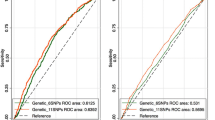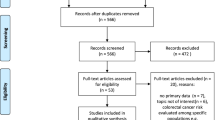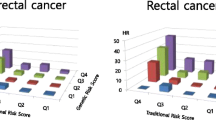Abstract
Before SNP-based risk can be incorporated in colorectal cancer (CRC) screening, the ability of these SNPs to estimate CRC risk for persons with and without a family history of CRC, and the screening implications need to be determined. We estimated the association with CRC of a 45 SNP-based risk using 1181 cases and 999 controls, and its correlation with CRC risk predicted from detailed family history. We estimated the predicted change in the distribution across predefined risk categories, and implications for recommended screening commencement age, from adding SNP-based risk to family history. The inter-quintile risk ratio for colorectal cancer risk of the SNP-based risk was 3.28 (95% CI 2.54–4.22). SNP-based and family history-based risks were not correlated (r = 0.02). For persons with no first-degree relatives with CRC, screening could commence 4 years earlier for women (5 years for men) in the highest quintile of SNP-based risk. For persons with two first-degree relatives with CRC, screening could commence 16 years earlier for men and women in the highest quintile, and 7 years earlier for the lowest quintile. This 45 SNP panel in conjunction with family history, can identify people who could benefit from earlier screening. Risk reclassification by 45 SNPs could inform targeted screening for CRC prevention, particularly in clinical genetics settings when mutations in high-risk genes cannot be identified. Yet to be determined is cost-effectiveness, resources requirements, community, patient and clinician acceptance, and feasibility with potentially ethical, legal and insurance implications.


Similar content being viewed by others
References
Win AK, Ait Ouakrim D, Jenkins MA (2014) Risk profiling: familial colorectal cancer. Cancer Forum 38(1):15–25
Hopper JL (2011) Disease-specific prospective family study cohorts enriched for familial risk. Epidemiol Perspect Innov 8(1):2. https://doi.org/10.1186/1742-5573-8-2
Dunlop MG, Tenesa A, Farrington SM, Ballereau S, Brewster DH, Koessler T et al (2013) Cumulative impact of common genetic variants and other risk factors on colorectal cancer risk in 42,103 individuals. Gut 62(6):871–881. https://doi.org/10.1136/gutjnl-2011-300537
Huyghe JR, Bien SA, Harrison TA, Kang HM, Chen S, Schmit SL et al (2019) Discovery of common and rare genetic risk variants for colorectal cancer. Nat Genet 51(1):76–87. https://doi.org/10.1038/s41588-018-0286-6
Jenkins MA, Makalic E, Dowty JG, Schmidt DF, Dite GS, MacInnis RJ et al (2016) Quantifying the utility of single nucleotide polymorphisms to guide colorectal cancer screening. Future Oncol 12(4):503–513. https://doi.org/10.2217/fon.15.303
Newcomb PA, Baron J, Cotterchio M, Gallinger S, Grove J, Haile R et al (2007) Colon Cancer Family Registry: an international resource for studies of the genetic epidemiology of colon cancer. Cancer Epidemiol Biomark Prev 16(11):2331–2343. https://doi.org/10.1158/1055-9965.EPI-07-0648
Stanesby O, Jenkins M (2017) Comparison of the efficiency of colorectal cancer screening programs based on age and genetic risk for reduction of colorectal cancer mortality. Eur J Hum Genet 25(7):832–838. https://doi.org/10.1038/ejhg.2017.60
Mealiffe ME, Stokowski RP, Rhees BK, Prentice RL, Pettinger M, Hinds DA (2010) Assessment of clinical validity of a breast cancer risk model combining genetic and clinical information. J Natl Cancer Inst 102(21):1618–1627. https://doi.org/10.1093/jnci/djq388
Hopper JL (2015) Odds per adjusted standard deviation: comparing strengths of associations for risk factors measured on different scales and across diseases and populations. Am J Epidemiol 182(10):863–867. https://doi.org/10.1093/aje/kwv193
Hopper JL, Carlin JB (1992) Familial aggregation of a disease consequent upon correlation between relatives in a risk factor measured on a continuous scale. Am J Epidemiol 136(9):1138–1147
Howlader NNA, Krapcho M, Garshell J, Miller D, Altekruse SF, Kosary CL, Yu M, Ruhl J, Tatalovich Z, Mariotto A, Lewis DR, Chen HS, Feuer EJ, Cronin KA (eds). SEER cancer statistics review, 1975–2011, External Web Site Icon National Cancer Institute. Bethesda, MD, http://seer.cancer.gov/csr/1975_2011/browse_csr.php?sectionSEL=6&pageSEL=sect_06_table.10.html based on November 2013 SEER data submission, posted to the SEER Web site, April 2014
Win AK, Jenkins MA, Dowty JG, Antoniou AC, Lee A, Giles GG et al (2017) Prevalence and penetrance of major genes and polygenes for colorectal cancer. Cancer Epidemiol Biomarkers Prev 26(3):404–412. https://doi.org/10.1158/1055-9965.EPI-16-0693
Howlader N, Noone A, Krapcho M, Garshell J, Miller D, Altekruse S et al (eds) (2014) SEER cancer statistics review, 1975-2011. Bethesda, National Cancer Institute
Force USPST, Bibbins-Domingo K, Grossman DC, Curry SJ, Davidson KW, Epling JW Jr et al (2016) Screening for colorectal cancer: US Preventive Services Task Force Recommendation Statement. JAMA 315(23):2564–2575. https://doi.org/10.1001/jama.2016.5989
StataCorp (2015) Stata statistical software: release 14. StataCorp LP, College Station
Lowery JT, Ahnen DJ, Schroy PC III, Hampel H, Baxter N, Boland CR et al (2016) Understanding the contribution of family history to colorectal cancer risk and its clinical implications: a state-of-the-science review. Cancer 122(17):2633–2645. https://doi.org/10.1002/cncr.30080
Dite GS, MacInnis RJ, Bickerstaffe A, Dowty JG, Allman R, Apicella C et al (2016) Breast cancer risk prediction using clinical models and 77 independent risk-associated SNPs for women aged under 50 years: Australian Breast Cancer Family Registry. Cancer Epidemiol Biomark Prev 25(2):359–365. https://doi.org/10.1158/1055-9965.EPI-15-0838
Frampton MJ, Law P, Litchfield K, Morris EJ, Kerr D, Turnbull C et al (2016) Implications of polygenic risk for personalised colorectal cancer screening. Ann Oncol 27(3):429–434. https://doi.org/10.1093/annonc/mdv540
Tenesa A, Dunlop MG (2009) New insights into the aetiology of colorectal cancer from genome-wide association studies. Nat Rev Genet 10(6):353–358
MacInnis RJ, Schmidt DF, Makalic E, Severi G, FitzGerald LM, Reumann M et al (2016) Use of a novel nonparametric version of DEPTH to identify genomic regions associated with prostate cancer risk. Cancer Epidemiol Biomark Prev 25(12):1619–1624. https://doi.org/10.1158/1055-9965.EPI-16-0301
Wei Z, Wang W, Bradfield J, Li J, Cardinale C, Frackelton E et al (2013) Large sample size, wide variant spectrum, and advanced machine-learning technique boost risk prediction for inflammatory bowel disease. Am J Hum Genet 92(6):1008–1012. https://doi.org/10.1016/j.ajhg.2013.05.002
Frampton M, Houlston RS (2017) Modeling the prevention of colorectal cancer from the combined impact of host and behavioral risk factors. Genet Med 19(3):314–321. https://doi.org/10.1038/gim.2016.101
Antoniou AC, Pharoah PDP, McMullan G, Day NE, Ponder BAJ, Easton D (2001) Evidence for further breast cancer susceptibility genes in addition to BRCA1 and BRCA2 in a population-based study. Genet Epidemiol 21(1):1–18
Cannings C, Thompson E, Skolnick M (1978) Probability functions on complex pedigrees. Adv Appl Prob 10(1):26–61
Curado MP, Edwards B, Shin HR, Storm H, Ferlay J, Heanue M et al (eds) (2007) Cancer incidence in five continents, vol IX. International Agency for Research on Cancer, Lyon
Pharoah PDP, Antoniou A, Bobrow M, Zimmern RL, Easton DF, Ponder BAJ (2002) Polygenic susceptibility to breast cancer and implications for prevention. Nat Genet 31(1):33–36
Wentzensen N, Wacholder S (2013) From differences in means between cases and controls to risk stratification: a business plan for biomarker development. Cancer Discov 3(2):148–157
Acknowledgements
The authors thank all study participants of the Colon Cancer Family Registry and staff for their contributions to this project.
Disclaimer
The content of this manuscript does not necessarily reflect the views or policies of the National Cancer Institute or any of the collaborating centres in the Colon Cancer Family Registry, nor does mention of trade names, commercial products, or organizations imply endorsement by the US Government or the Colon Cancer Family Registry. Authors had full responsibility for the design of the study, the collection of the data, the analysis and interpretation of the data, the decision to submit the manuscript for publication, and the writing of the manuscript.
Funding
This work was supported by Grant U01 CA167551 from the National Cancer Institute and through cooperative agreements with the following Colon Cancer Family Registry sites: Australasian Colorectal Cancer Family Registry (U01 CA074778 and U01/U24 CA097735); Ontario Familial Colorectal Cancer Registry (U01/U24 CA074783); and Seattle Colorectal Cancer Family Registry (U01/U24 CA074794). The genome wide association studies (GWAS) were supported by Grants U01 CA 122839, R01 CA143237 and U19 CA148107. Additional support for case ascertainment was provided from the Surveillance, Epidemiology and End Results (SEER) Program of the National Cancer Institute to Fred Hutchinson Cancer Research Center (Control Nos. N01-CN-67009 and N01-PC-35142, and Contract No. HHSN2612013000121), the following U.S. state cancer registries: AZ, CO, MN, NC, NH, and by the Victorian Cancer Registry, Australia and the Ontario Cancer Registry, Canada. This work was also supported by grant R01CA170122 from NIH, and Centre for Research Excellence grant APP1042021 and Program Grant APP1074383 from the National Health and Medical Research Council (NHMRC), Australia. MAJ is a NHMRC Senior Research Fellow. AKW is a NHMRC Career Development Fellow. DDB is a NHMRC R.D. Wright Career Development Fellow and a University of Melbourne Research at Melbourne Accelerator Program (R@MAP) Senior Research Fellow. JLH is a NHMRC Senior Principal Research Fellow.
Author information
Authors and Affiliations
Contributions
MAJ conceived the aims; MAJ, AKW, JGD, RJM conducted the analyses and were major contributors to the manuscript; EM, DFS, GSD, MK derived the SNP scores and provided contributions to the manuscript; CR, IMW, JDE, SS, FAM, DJA, DD provided interpretation of the findings and provided contributions to the manuscript; JCF, NML, RWH, JDP, MC, SG, PAN, DDB, GC, JLH led recruitment and genetic testing and provided contributions to the manuscript. All authors read and approved the final manuscript.
Corresponding author
Ethics declarations
Conflict of interest
Genetype Pty Ltd have provided research support to MAJ and JLH and provided salary support for GSD. The other authors have no conflict of interest to declare with respect to this manuscript.
Additional information
Publisher's Note
Springer Nature remains neutral with regard to jurisdictional claims in published maps and institutional affiliations.
Electronic supplementary material
Below is the link to the electronic supplementary material.
Appendix
Appendix
Risk distributions
The distribution of the risk under a genetic mixed model, which incorporates major gene and an unmeasured polygene components [23, 24], was calculated as follows.
The polygene component modelled the combined effect on colorectal cancer (CRC) susceptibility of a large number of independent genetic loci that individually have small, multiplicative effects on the incidence of CRC. Therefore the polygene was modelled as a normally distributed random variable \(X \sim N\left( {\mu ,\sigma^{2} } \right)\) with mean μ and standard deviation σ, and the incidence of CRC at age t years for a person with polygene X = x was modelled as \(e^{x} HR_{major} \lambda_{0} \left( t \right)\), where HRmajor is the hazard ratio corresponding to the person’s genotype at the major gene (which is assumed to be independent of X) and \(\lambda_{0} \left( t \right)\) is the population incidence at age t years. Note that we therefore must take \(\mu = - \sigma^{2} /2\) to ensure that the population incidence \(\lambda_{0} \left( t \right)\) is the average incidence for persons with HRmajor = 1.
The age-specific CRC incidence is the hazard function of the random variable T giving the age at CRC diagnosis of a person who is randomly selected from the population. Therefore the cumulative risk to age 80 years for someone with polygene X = x and a major gene hazard ratio of HRmajor is
where \({\text{s}} = \exp \left( { - \mathop \smallint \limits_{0}^{80} \lambda_{0} \left( t \right)dt} \right)\) is the survival probability to age 80 years for someone at population risk. Inverting this equation therefore gives the cumulative distribution function of Pen(X)(since, for any c between 0 and 1, we have
where \(\varPhi\) is the cumulative distribution function for \(X \sim N\left( { - \sigma^{2} /2 ,\sigma^{2} } \right)\).
In this paper, we took the population incidence \(\lambda_{0} \left( t \right)\) to be the age-specific CRC incidence for the USA 1998–2002, averaged over sex [25]. For the main analyses we also took a polygenic standard deviation of σ = 1.124, since this corresponds under Pharoah’s formula [26] to a familial relative risk of 1.88, which is the residual familial relative risk for CRC after accounting for the effects of 45 known CRC-associated SNPs [5].
Adjustment for oversampling of controls for not having a family history from the Colon Cancer Family Registry Phase I GWAS dataset that used for SNP-based risk estimation
Controls were preferentially selected for GWAS Phase-I testing if they had no family history of CRC, so we would expect them to have a slightly different distribution of the 45 SNP score K compared with controls if they had been recruited regardless of family history. Simulations were used to assess the differences between the distributions of K in these two groups of controls, and the effect of these differences on our final odds ratio estimates.
We considered a nuclear family consisting of two parents (individuals i = 1 and i = 2) and two children (individuals i = 3 and i = 4). As above, we decomposed the polygene \(X_{i} = K_{i} + U_{i}\) for person i in the nuclear family into a component Ki due to the 45 known SNPs and an independent component Ui due to all other unknown genetic variants that are associated with CRC. We assumed \(K_{i} \sim N\left( { - \sigma_{K}^{2} /2 ,\sigma_{K}^{2} } \right)\) and \(U_{i} \sim N\left( { - \sigma_{U}^{2} /2 ,\sigma_{U}^{2} } \right)\) with σU = 0.6011 and σK = 1.124, as above. We also assumed that the joint distribution of K1,K2,K3,K4 followed a multivariate normal distribution with the correlation between parents being 0 and the correlation between all other pairs of (first-degree) family members being 0.5, and similarly for U1,U2,U3,U4. As above (but with HRmajor = 1), we assumed that if individual i has Ki= k and Ui= u then he or she has a lifetime CRC risk \(1 - s^{{e^{k + u} }}\). We then used these assumptions to simulate the known SNP scores K1,K2,K3,K4, the unknown variant scores U1,U2,U3,U4 and the (lifetime) affected statuses of all four family members, and we did this for 10,000,000 nuclear families. The distribution of the known variant score K4 for individual i = 4 (one of the children) was calculated firstly for all families with no affected family members and secondly for all families where individual i = 4 was unaffected. The means of K4 in these two types of families were − 0.385 and − 0.361, respectively, and the standard deviations of K4 in these two types of families were both 0.60. Therefore the known variant score K4 for controls with a null family history was shifted by − 0.021 compared to controls ascertained regardless of family history, which is − 0.021/0.60 = − 0.035 standard deviations. For a risk factor which, in cases and controls, is normally distributed with the same standard deviation and a difference in means of Δ standard deviations, it can be shown that the odds ratio is exp(Δ) [27]. Our simulations show that our ascertainment criterion is causing us to overestimate Δ by 0.035, so we are therefore overestimating the odds ratio by a factor of exp(0.035) = 1.04, i.e. by 4%.
Rights and permissions
About this article
Cite this article
Jenkins, M.A., Win, A.K., Dowty, J.G. et al. Ability of known susceptibility SNPs to predict colorectal cancer risk for persons with and without a family history. Familial Cancer 18, 389–397 (2019). https://doi.org/10.1007/s10689-019-00136-6
Published:
Issue Date:
DOI: https://doi.org/10.1007/s10689-019-00136-6




